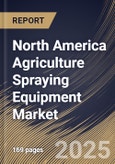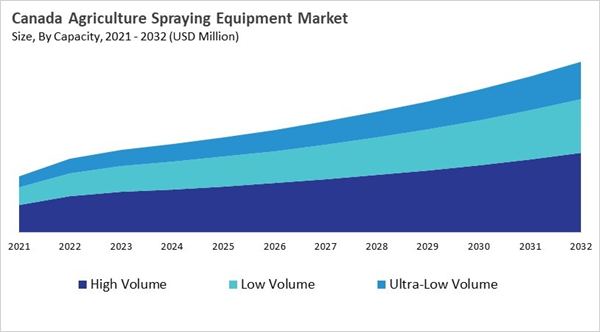The US market dominated the North America Agriculture Spraying Equipment Market by country in 2024, and is expected to continue to be a dominant market till 2032; thereby, achieving a market value of $897.2 Million by 2032. The Canada market is experiencing a CAGR of 8.7% during 2025-2032. Additionally, the Mexico market is expected to exhibit a CAGR of 7.8% during 2025-2032.
The market for agricultural spraying equipment in North America has changed from manual sprayers to very modern, GPS-guided systems. This is because farms have grown, pests have become more of a problem, and new technologies have been developed. Pivotal changes, like the first aerial crop dusting in 1921 and LiDAR-enabled systems like Smart Apply, have changed how pesticides are used. Farmers may now use precision agriculture, VRT, and auto-steering technology to get more out of their crops while using less chemicals. This is in line with increasing environmental requirements and data-driven farming methods.
Three important factors are shaping the market today: automation, precision spraying, and digital ecosystem integration. Farmers increasingly deploy robotic sprayers, UAVs, and solar-powered devices for high-value and terrain-sensitive crops, facilitated by real-time data platforms from OEMs such as John Deere and AGCO. The North American market is still the best place to get environmentally friendly and cost-effective spraying solutions that fulfill both economic and environmental needs. This is because both new and established companies are competing by coming up with new ideas and delivering services in certain areas.
Country Outlook
United States :The market for U.S. agriculture spraying equipment is doing well because of big farms, better mechanization, and a move toward precision agriculture. Farmers are utilizing more and more GPS-enabled, variable-rate, and drone-mounted sprayers to get better yields, cut down on waste, and deal with a lack of workers. Federal incentives and environmental rules make adoption more likely, while industry leaders like John Deere and AGCO lead the way with tech-savvy solutions like IoT-enabled Hagie, Blue River, and RoGator systems.New developments include drone-based sprayers and upgrades for existing machines that fulfill the needs for efficiency and following the rules. But smaller farms have trouble with large upfront costs, especially for self-propelled devices, because they have to keep paying for upkeep and prices for inputs can change. Possible tariffs and complicated rules add to the uncertainty, therefore price and support are very important when buying equipment.
List of Key Companies Profiled
- Deere & Company
- CNH Industrial N.V.
- AGCO Corporation
- KUBOTA Corporation
- Andreas Stihl AG and Co KG
- Buhler Industries Inc.
- Yamaha Motor Co., Ltd.
- ISEKI & Co., Ltd.
- Mahindra & Mahindra Limited (Mahindra Group)
- SZ DJI Technology Co., Ltd.
Market Report Segmentation
By Farm Size
- Medium Farms
- Large Farms
- Small Farms
By Capacity
- High Volume
- Low Volume
- Ultra-Low Volume
By Type
- Self-propelled
- Tractor-mounted
- Trailed
- Aerial
- Handheld
By Country
- US
- Canada
- Mexico
- Rest of North America
Table of Contents
Companies Mentioned
- Deere & Company
- CNH Industrial N.V.
- AGCO Corporation
- KUBOTA Corporation
- Andreas Stihl AG and Co KG
- Buhler Industries Inc.
- Yamaha Motor Co., Ltd.
- ISEKI & Co., Ltd.
- Mahindra & Mahindra Limited (Mahindra Group)
- SZ DJI Technology Co., Ltd.









